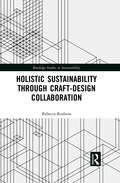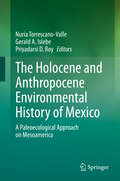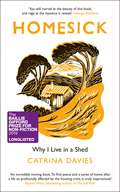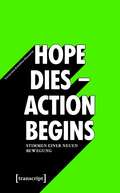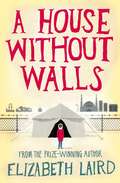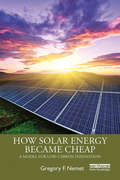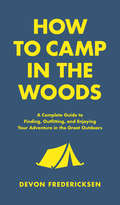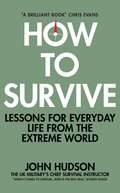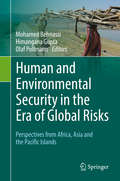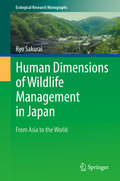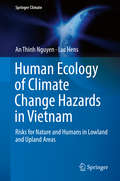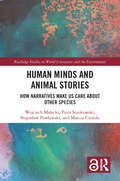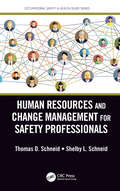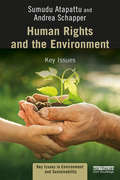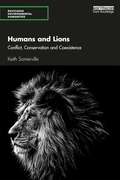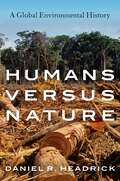- Table View
- List View
Holistic Sustainability Through Craft-Design Collaboration (Routledge Studies in Sustainability)
by Rebecca ReubensThis book explores the intersection of craft, design and sustainability in the developing world. It argues that most sustainable design approaches and efforts fall short of implementing holistic sustainability, and in order to reach this goal, design must be underpinned by alternatives to the mainstream, technology-intensive, industrial design paradigm. Renewable materials such as bamboo, cork and hemp – which are abundantly available in the developing world – have the potential to be a viable resource base for sustainable development. Current sustainable design initiatives and approaches already recontextualize these materials using industrial techniques and technologies. However, these efforts fall short of impacting holistic sustainability and tend to focus on the ecological aspect. This book offers the development of one alternative to design for holistic sustainability, called the Rhizome Approach, which draws on existing sustainability praxis and craft. Holistic Sustainability Through Craft-Design Collaboration includes customizable tools which aim to empower designers to guide and evaluate their own designs. Through these tools, and the Rhizome Approach in general, the book aims to enable designers, and students of design, to move beyond green and sustainable design, to holistic sustainability design.
Holistic Sustainability Through Craft-Design Collaboration (Routledge Studies in Sustainability)
by Rebecca ReubensThis book explores the intersection of craft, design and sustainability in the developing world. It argues that most sustainable design approaches and efforts fall short of implementing holistic sustainability, and in order to reach this goal, design must be underpinned by alternatives to the mainstream, technology-intensive, industrial design paradigm. Renewable materials such as bamboo, cork and hemp – which are abundantly available in the developing world – have the potential to be a viable resource base for sustainable development. Current sustainable design initiatives and approaches already recontextualize these materials using industrial techniques and technologies. However, these efforts fall short of impacting holistic sustainability and tend to focus on the ecological aspect. This book offers the development of one alternative to design for holistic sustainability, called the Rhizome Approach, which draws on existing sustainability praxis and craft. Holistic Sustainability Through Craft-Design Collaboration includes customizable tools which aim to empower designers to guide and evaluate their own designs. Through these tools, and the Rhizome Approach in general, the book aims to enable designers, and students of design, to move beyond green and sustainable design, to holistic sustainability design.
The Holocene and Anthropocene Environmental History of Mexico: A Paleoecological Approach on Mesoamerica
by Nuria Torrescano-Valle Gerald A. Islebe Priyadarsi D. RoyThis book provides essential information on Mexico’s Holocene and Anthropocene climate and vegetation history. Considering the geography of Mexico – which is home to a variety of climatic and environmental conditions, from desert and tropical to high mountain climates – this book focuses on its postglacial paleoecology and paleoclimatology. Further, it analyses human intervention since the middle Holocene as a major agent of environmental change. Offering a valuable tool for understanding past climate change and its relationship with present climate change, the book is a must-read for botanists, ecologists, palaeontologists and graduate students in related fields.
Homesick: Why I Live in a Shed
by Catrina DaviesThe story of a personal housing crisis that led to a discovery of the true value of home.*'You will marvel at the beauty of this book, and rage at the injustice it reveals' George Monbiot**'Incredibly moving. To find peace and a sense of home after a life so profoundly affected by the housing crisis, is truly inspirational' Raynor Winn, bestselling author of The Salt Path*Aged thirty-one, Catrina Davies was renting a box-room in a house in Bristol, which she shared with four other adults and a child. Working several jobs and never knowing if she could make the rent, she felt like she was breaking apart. Homesick for the landscape of her childhood, in the far west of Cornwall, Catrina decides to give up the box-room and face her demons. As a child, she saw her family and their security torn apart; now, she resolves to make a tiny, dilapidated shed a home of her own.With the freedom to write, surf and make music, Catrina rebuilds the shed and, piece by piece, her own sense of self. On the border of civilisation and wilderness, between the woods and the sea, she discovers the true value of home, while trying to find her place in a fragile natural world.This is the story of a personal housing crisis and a country-wide one, grappling with class, economics, mental health and nature. It shows how housing can trap us or set us free, and what it means to feel at home.
»Hope dies - Action begins«: Stimmen einer neuen Bewegung (X-Texte zu Kultur und Gesellschaft)
by Extinction Rebellion Hannover»Hope dies - Action begins« - so lautet das Motto der neuen weltweiten Umweltbewegung »Extinction Rebellion« (XR). XR will uns alle dafür sensibilisieren, endlich radikale Maßnahmen gegen das gigantische Artensterben und die Klimakatastrophe zu ergreifen. In diesem Buch kommen XR-Aktivist*innen zu Wort, die XR-Forderungen, XR-Prinzipien & Werte und XR-Aktionen aus ihrer je eigenen Sichtweise erläutern. Dadurch sollen Leser*innen ermutigt werden, sich mit dieser Bewegung und ihren Zielen auseinanderzusetzen. XR bedeutet Rebellion für das Leben.
»Hope dies - Action begins«: Stimmen einer neuen Bewegung (X-Texte zu Kultur und Gesellschaft)
by Extinction Rebellion Hannover»Hope dies - Action begins« - so lautet das Motto der neuen weltweiten Umweltbewegung »Extinction Rebellion« (XR). XR will uns alle dafür sensibilisieren, endlich radikale Maßnahmen gegen das gigantische Artensterben und die Klimakatastrophe zu ergreifen. In diesem Buch kommen XR-Aktivist*innen zu Wort, die XR-Forderungen, XR-Prinzipien & Werte und XR-Aktionen aus ihrer je eigenen Sichtweise erläutern. Dadurch sollen Leser*innen ermutigt werden, sich mit dieser Bewegung und ihren Zielen auseinanderzusetzen. XR bedeutet Rebellion für das Leben.
A House Without Walls
by Elizabeth LairdA House Without Walls is a powerful story of family, hope and redemption amidst the refugee crisis in Syria from the award-winning Elizabeth Laird, illustrated by Lucy Eldridge.Thirteen-year-old Safiya and her family have been driven out of Syria by civil war. Safiya knows how lucky she is – lucky not to be living in a refugee camp, lucky to be alive. But it's hard to feel grateful when she's forced to look after her father and brother rather than go back to school, and now that she's lost her home, she's lonelier than ever. As they struggle to rebuild their lives, Safiya realizes that her family has always been incomplete and with her own future in the balance, it's time to uncover the secrets that war has kept buried.
The House Without Windows
by Barbara Newhall Follett'An enchanting book. These pages simply quiver with the beauty, happiness and vigour of forests, seas and mountains . . . I can safely promise joy to any reader of it. Perfection' Eleanor Farjeon, Winner of the Carnegie Medal and The Hans Christian Andersen AwardDiscover this extraordinary lost classic of nature writing - a fable about wildness and the desire to escape - beautifully illustrated by beloved artist and The Lost Words creator Jackie Morris'Miraculous - a fearless odyssey into a dreamtime of wildness and enchantment. Gloriously illuminated by Jackie Morris's moving art, this is a work of strange power for our own bewildered times' Nick DrakeLittle Eepersip doesn't want to live in a house with doors and windows and a roof, so she runs away to live in the wild - first in the Meadow, then by the Sea, and finally in the Mountain. Her heartbroken parents follow her at first, bringing her back home to 'safety' and locking her up in the stifling square of the house. But she slips away once more, following her wild heart out of the door and far away...Barbara Newhall Follett was just thirteen years old when she published The House Without Windows in 1927. The book went on to become a million-copy bestseller. Years later, as an adult herself, Barbara followed in the footsteps of her radical heroine - dissatisfied with the limitations of life as a respectable married woman, she walked out of her house one day and simply disappeared.Penguin are delighted to republish Barbara Newhall Follett's extraordinary feminist fable for the next generation of nature lovers and escapees to discover and cherish. Newly introduced by Jackie Morris, and filled with her beautifully inked artwork, The House Without Windows is an irresistible paean to the natural world and its transcendent effect on the human heart.'A classic, as miraculous and awe-inspiring as the nine-year-old author. Jackie Morris portrays the artistic elegance of the eastern ink with the wisdom of the West' Xinran, author of The Good Women of China Praise for The Lost Words'Breathtaking . . . Jackie Morris has created something that you could spend all day looking at' New Statesman'Luminous' Sunday Times'Sumptuous . . . A book combining meticulous wordcraft with exquisite illustrations deftly restores language describing the natural world to the children's lexicon...The Lost Words is a beautiful book and an important one' Observer
How Solar Energy Became Cheap: A Model for Low-Carbon Innovation
by Gregory F. NemetSolar energy is a substantial global industry, one that has generated trade disputes among superpowers, threatened the solvency of large energy companies, and prompted serious reconsideration of electric utility regulation rooted in the 1930s. One of the biggest payoffs from solar’s success is not the clean inexpensive electricity it can produce, but the lessons it provides for innovation in other technologies needed to address climate change. Despite the large literature on solar, including analyses of increasingly detailed datasets, the question as to how solar became inexpensive and why it took so long still remains unanswered. Drawing on developments in the US, Japan, Germany, Australia, and China, this book provides a truly comprehensive and international explanation for how solar has become inexpensive. Understanding the reasons for solar’s success enables us to take full advantage of solar’s potential. It can also teach us how to support other low-carbon technologies with analogous properties, including small modular nuclear reactors and direct air capture. However, the urgency of addressing climate change means that a key challenge in applying the solar model is in finding ways to speed up innovation. Offering suggestions and policy recommendations for accelerated innovation is another key contribution of this book. This book will be of great interest to students and scholars of energy technology and innovation, climate change and energy analysis and policy, as well as practitioners and policymakers working in the existing and emerging energy industries.
How Solar Energy Became Cheap: A Model for Low-Carbon Innovation
by Gregory F. NemetSolar energy is a substantial global industry, one that has generated trade disputes among superpowers, threatened the solvency of large energy companies, and prompted serious reconsideration of electric utility regulation rooted in the 1930s. One of the biggest payoffs from solar’s success is not the clean inexpensive electricity it can produce, but the lessons it provides for innovation in other technologies needed to address climate change. Despite the large literature on solar, including analyses of increasingly detailed datasets, the question as to how solar became inexpensive and why it took so long still remains unanswered. Drawing on developments in the US, Japan, Germany, Australia, and China, this book provides a truly comprehensive and international explanation for how solar has become inexpensive. Understanding the reasons for solar’s success enables us to take full advantage of solar’s potential. It can also teach us how to support other low-carbon technologies with analogous properties, including small modular nuclear reactors and direct air capture. However, the urgency of addressing climate change means that a key challenge in applying the solar model is in finding ways to speed up innovation. Offering suggestions and policy recommendations for accelerated innovation is another key contribution of this book. This book will be of great interest to students and scholars of energy technology and innovation, climate change and energy analysis and policy, as well as practitioners and policymakers working in the existing and emerging energy industries.
How to Camp in the Woods: A Complete Guide to Finding, Outfitting, and Enjoying Your Adventure in the Great Outdoors (In The Woods)
by Devon FredericksenImmerse yourself in the natural world with How to Camp in the Woods, the book StarTribune says "does all but set up the tent."Perfect for everyone from novices to boondockers, How to Camp in the Woods compiles contemporary and classic wisdom, practical tips, and illustrated DIY advice on every aspect of equipping, packing, setting up camp, cooking, and improvising no matter where you are in the great outdoors. How to Camp in the Woods will teach readers: Camping and survival basics including fire building, essential knots, site finding, wilderness first aid/CPR, map/compass reading, and camping off the grid. Essential gear, packing light, recommendations for DIY if you've left something behind, and how to keep everything relatively clean. Guides to camping comfortably in all seasons and weather, as well as tips and etiquette for camping around the world, including with pets and kids. Tips for enhancing the experience, including recipes for easy and inexpensive meals from 25 base ingredients, stargazing essentials, fireside games and songs, bird-watching, and the perfect campfire reading list.
How to Camp in the Woods: A Complete Guide to Finding, Outfitting, and Enjoying Your Adventure in the Great Outdoors (In the Woods)
by Devon FredericksenImmerse yourself in the natural world with How to Camp in the Woods, the book StarTribune says "does all but set up the tent."Perfect for everyone from novices to boondockers, How to Camp in the Woods compiles contemporary and classic wisdom, practical tips, and illustrated DIY advice on every aspect of equipping, packing, setting up camp, cooking, and improvising no matter where you are in the great outdoors. How to Camp in the Woods will teach readers:Camping and survival basics including fire building, essential knots, site finding, wilderness first aid/CPR, map/compass reading, and camping off the grid. Essential gear, packing light, recommendations for DIY if you've left something behind, and how to keep everything relatively clean. Guides to camping comfortably in all seasons and weather, as well as tips and etiquette for camping around the world, including with pets and kids. Tips for enhancing the experience, including recipes for easy and inexpensive meals from 25 base ingredients, stargazing essentials, fireside games and songs, bird-watching, and the perfect campfire reading list.
How to Survive: Lessons for Everyday Life from the Extreme World
by John Hudson'When it comes to survival and getting out of trouble, listen to this man. John is the real deal.'Levison WoodWhat is the connection between crawling through a jungle and your ‘to do’ list? What can ejecting out of a stealth bomber teach you about the importance of thinking the worst? What can surviving in extreme situations teach us about surviving everyday life?John Hudson, Chief Survival Instructor to the British Military, knows what it takes to survive. Combining first-hand experience with 20 years of studying the choices people have made under the most extreme pressure, How to Survive is a lifetime’s worth of wisdom about how to apply the principles of survival to everyday life.The cornerstone of military survival (surviving anything) is understanding the relationship between effort, hope and goals – a mindset that can be transposed anytime, anywhere. In How to Survive you will learn how this template for survival can be applied to any situation in your everyday life.Through gripping first-hand accounts of near disaster and survival stories from across the extreme world you will learn that by following these principles you can develop the mindset that will allow you to make better decisions under pressure, which are as equally applicable to first dates and presentations as to climbing Everest and getting lost at sea.
Human and Environmental Security in the Era of Global Risks: Perspectives From Africa, Asia And The Pacific Islands
by Mohamed Behnassi Himangana Gupta Olaf PollmannThis book discusses ways to deepen the debate on the linkages between global risks and human and environmental security. The approach put forward in this book is one of questioning the ability of existing concepts, regulatory frameworks, technologies and decision-making mechanisms to accurately deal with emerging risks to human and environmental security, and to act in the direction of effectively managing their impacts and fostering the resilience of concerned systems and resources. Empirical research findings from Africa, Asia and the Pacific Islands are provided.During the last decades the links between emerging risks and the security of humans and nature have been the object of considerable research and deliberations. However, it is only recently becoming an important focus of policy making and advocacy. In this contributed volume, it is presumed that the ability – or lack thereof – to make innovative conceptual frameworks, institutional and policy arrangements, and technological advances for managing the current emerging risks, will foster or undermine the environmental security, and consequently determine the future human security. Moreover, taking into account the links between environmental/climate security, human security and sustainability will help frame a new research agenda and potentially develop a broad range of responses to many delicate questions.
Human Dimensions of Wildlife Management in Japan: From Asia to the World (Ecological Research Monographs)
by Ryo SakuraiThis book discusses the findings of research on the human dimensions of wildlife management conducted in Japan, demonstrating how such research and approaches have contributed to mitigating human-wildlife conflicts.Human-wildlife conflicts, including agricultural and property damage as well as occasional casualties, are a global problem for which local residents, managers, and stakeholders around the world are struggling to find solutions. Human dimensions of wildlife management (HDW) is an academic field developed in North America in the 1970s to gather information on the social aspects of human-wildlife issues to help wildlife managers and stakeholders implement effective decision-making measures. However, HDW is not widely recognized or applied outside North America, and few studies have investigated whether HDW approaches would be effective in different cultural settings.This is the first book written in English to introduce the HDW theories and practices implemented in Asia. Presenting innovative approaches and research techniques, as well as tips on how to introduce HDW methods into culturally different societies, it is a valuable resource not only for researchers and students in this field, but also for government officials/managers, NGOs, residents and other stakeholders who are affected by human-wildlife conflicts around the globe.
Human Ecology of Climate Change Hazards in Vietnam: Risks for Nature and Humans in Lowland and Upland Areas (Springer Climate)
by An Thinh Nguyen Luc HensThis book analyzes climate change associated effects in the mountainous and coastal environments of Vietnam. The scope of the book allows international comparisons to be made between these two affected areas and other similarly affected locations under constant environmental pressure. Frequent and intense climate change hazards are described, along with a wider context of integrated interpretations, socioeconomic implications and policy responses. The book reports on original research combining methodologies from the natural sciences with approaches in human sciences, providing an interdisciplinary human ecological context to analyze similar situations worldwide. The book is structured in four parts. The first part offers background information, and details the human ecological framework. The geography of the analyzed regions is discussed to reflect the environmental and socioeconomic context of Vietnam's coasts and mountains. The second part addresses the coast of Central Vietnam. The effects of tropical storms, floods, rising sea levels and coastal erosion in Ky Anh are studied to highlight the impacts on the local population and its development perspectives. The third part focuses on the uplands of Northern Vietnam. The effects of cyclones, heavy rains, floods, flash floods, and landslides in the Van Chan Mountains are studied to compare the biophysical and socioeconomic impacts. Part four makes policy recommendations in building resilient landscapes and green cities, and discusses the potential implications of findings for practice in Vietnam. The book addresses a wide array of researchers, geography and economics students, consultants and decision makers interested in the actual status and the likely developments on the physical, socioeconomic and mitigation and adaptation attitudes and policies of climate change associated effects.
Human Minds and Animal Stories: How Narratives Make Us Care About Other Species (Routledge Studies in World Literatures and the Environment)
by Wojciech Małecki Piotr Sorokowski Bogusław Pawłowski Marcin CieńskiThe power of stories to raise our concern for animals has been postulated throughout history by countless scholars, activists, and writers, including such greats as Thomas Hardy and Leo Tolstoy. This is the first book to investigate that power and explain the psychological and cultural mechanisms behind it. It does so by presenting the results of an experimental project that involved thousands of participants, texts representing various genres and national literatures, and the cooperation of an internationally-acclaimed bestselling author. Combining psychological research with insights from animal studies, ecocriticism and other fields in the environmental humanities, the book not only provides evidence that animal stories can make us care for other species, but also shows that their effects are more complex and fascinating than we have ever thought. In this way, the book makes a groundbreaking contribution to the study of relations between literature and the nonhuman world as well as to the study of how literature changes our minds and society. "As witnessed by novels like Black Beauty and Uncle Tom’s Cabin, a good story can move public opinion on contentious social issues. In Human Minds and Animal Stories a team of specialists in psychology, biology, and literature tells how they discovered the power of narratives to shift our views about the treatment of other species. Beautifully written and based on dozens of experiments with thousands of subjects, this book will appeal to animal advocates, researchers, and general readers looking for a compelling real-life detective story." - Hal Herzog, author of Some We Love, Some We Hate, Some We Eat : Why It’s So Hard To Think Straight About Animals
Human Minds and Animal Stories: How Narratives Make Us Care About Other Species (Routledge Studies in World Literatures and the Environment)
by Wojciech Małecki Piotr Sorokowski Bogusław Pawłowski Marcin CieńskiThe power of stories to raise our concern for animals has been postulated throughout history by countless scholars, activists, and writers, including such greats as Thomas Hardy and Leo Tolstoy. This is the first book to investigate that power and explain the psychological and cultural mechanisms behind it. It does so by presenting the results of an experimental project that involved thousands of participants, texts representing various genres and national literatures, and the cooperation of an internationally-acclaimed bestselling author. Combining psychological research with insights from animal studies, ecocriticism and other fields in the environmental humanities, the book not only provides evidence that animal stories can make us care for other species, but also shows that their effects are more complex and fascinating than we have ever thought. In this way, the book makes a groundbreaking contribution to the study of relations between literature and the nonhuman world as well as to the study of how literature changes our minds and society. "As witnessed by novels like Black Beauty and Uncle Tom’s Cabin, a good story can move public opinion on contentious social issues. In Human Minds and Animal Stories a team of specialists in psychology, biology, and literature tells how they discovered the power of narratives to shift our views about the treatment of other species. Beautifully written and based on dozens of experiments with thousands of subjects, this book will appeal to animal advocates, researchers, and general readers looking for a compelling real-life detective story." - Hal Herzog, author of Some We Love, Some We Hate, Some We Eat : Why It’s So Hard To Think Straight About Animals
Human Resources and Change Management for Safety Professionals (Occupational Safety & Health Guide Series)
by Thomas D. Schneid Shelby L. SchneidThe goal of this book is to prepare safety and health professionals to recognize and address human resource issues, applicable laws and regulations, as well as change management techniques used to alter the safety culture within their operations. This book will provide awareness to avoid or address HR related policies/issues/laws which can result in costly litigation, grievances, and other negative implications. The book will address the "pitfalls" for safety professionals to avoid as well as provide the methodology to attain the cultural change necessary to achieve and maintain safety performance. Features Prepares safety professionals how to avoid or address HR issues and laws Provides awareness of applicable labor and employment laws and regulations Covers change management skills applicable to the safety function Enables the safety professional to recognize legal requirements from everyday questions asked by employees Helps safety professionals to prevent becoming entangled in legal issues resulting from their actions or inactions
Human Resources and Change Management for Safety Professionals (Occupational Safety & Health Guide Series)
by Thomas D. Schneid Shelby L. SchneidThe goal of this book is to prepare safety and health professionals to recognize and address human resource issues, applicable laws and regulations, as well as change management techniques used to alter the safety culture within their operations. This book will provide awareness to avoid or address HR related policies/issues/laws which can result in costly litigation, grievances, and other negative implications. The book will address the "pitfalls" for safety professionals to avoid as well as provide the methodology to attain the cultural change necessary to achieve and maintain safety performance. Features Prepares safety professionals how to avoid or address HR issues and laws Provides awareness of applicable labor and employment laws and regulations Covers change management skills applicable to the safety function Enables the safety professional to recognize legal requirements from everyday questions asked by employees Helps safety professionals to prevent becoming entangled in legal issues resulting from their actions or inactions
Human Rights and the Environment: Key Issues (Key Issues in Environment and Sustainability)
by Sumudu Atapattu Andrea SchapperThe field of human rights and the environment has grown phenomenally during the last few years and this textbook will be one of the first to encourage students to think critically about how many environmental issues lead to a violation of existing rights. Taking a socio-legal approach, this book will provide a good understanding of both human rights and environmental issues, as well as the limitations of each regime, and will explore the ways in which human rights law and institutions can be used to obtain relief for the victims of environmental degradation or of adverse effects of environmental policies. In addition, it will place an emphasis on climate change and climate policies to highlight the pros and cons of using a human rights framework and to underscore its importance in the context of climate change. As well as identifying emerging issues and areas for further research, each chapter will be rich in pedagogical features, including web links to further research and discussion questions for beyond the classroom. Combining their specialisms in law and politics, Atapattu and Schapper have developed a truly inter-disciplinary resource that will be essential for students of human rights, environmental studies, international law, international relations, politics, and philosophy.
Human Rights and the Environment: Key Issues (Key Issues in Environment and Sustainability)
by Sumudu Atapattu Andrea SchapperThe field of human rights and the environment has grown phenomenally during the last few years and this textbook will be one of the first to encourage students to think critically about how many environmental issues lead to a violation of existing rights. Taking a socio-legal approach, this book will provide a good understanding of both human rights and environmental issues, as well as the limitations of each regime, and will explore the ways in which human rights law and institutions can be used to obtain relief for the victims of environmental degradation or of adverse effects of environmental policies. In addition, it will place an emphasis on climate change and climate policies to highlight the pros and cons of using a human rights framework and to underscore its importance in the context of climate change. As well as identifying emerging issues and areas for further research, each chapter will be rich in pedagogical features, including web links to further research and discussion questions for beyond the classroom. Combining their specialisms in law and politics, Atapattu and Schapper have developed a truly inter-disciplinary resource that will be essential for students of human rights, environmental studies, international law, international relations, politics, and philosophy.
Humans and Lions: Conflict, Conservation and Coexistence (Routledge Environmental Humanities)
by Keith SomervilleThis book places lion conservation and the relationship between people and lions both in historical context and in the context of the contemporary politics of conservation in Africa. The killing of Cecil the Lion in July 2015 brought such issues to the public’s attention. Were lions threatened in the wild and what was the best form of conservation? How best can lions be saved from extinction in the wild in Africa amid rural poverty, precarious livelihoods for local communities and an expanding human population? This book traces man’s relationship with lions through history, from hominids, to the Romans, through colonial occupation and independence, to the present day. It concludes with an examination of the current crisis of conservation and the conflict between Western animal welfare concepts and sustainable development, thrown into sharp focus by the killing of Cecil the lion. Through this historical account, Keith Somerville provides a coherent, evidence-based assessment of current human-lion relations, providing context to the present situation. This book will be of interest to students and scholars of environmental and African history, wildlife conservation, environmental management and political ecology, as well as the general reader.
Humans and Lions: Conflict, Conservation and Coexistence (Routledge Environmental Humanities)
by Keith SomervilleThis book places lion conservation and the relationship between people and lions both in historical context and in the context of the contemporary politics of conservation in Africa. The killing of Cecil the Lion in July 2015 brought such issues to the public’s attention. Were lions threatened in the wild and what was the best form of conservation? How best can lions be saved from extinction in the wild in Africa amid rural poverty, precarious livelihoods for local communities and an expanding human population? This book traces man’s relationship with lions through history, from hominids, to the Romans, through colonial occupation and independence, to the present day. It concludes with an examination of the current crisis of conservation and the conflict between Western animal welfare concepts and sustainable development, thrown into sharp focus by the killing of Cecil the lion. Through this historical account, Keith Somerville provides a coherent, evidence-based assessment of current human-lion relations, providing context to the present situation. This book will be of interest to students and scholars of environmental and African history, wildlife conservation, environmental management and political ecology, as well as the general reader.
Humans versus Nature: A Global Environmental History
by Daniel R. HeadrickSince the appearance of Homo sapiens on the planet hundreds of thousands of years ago, human beings have sought to exploit their environments, extracting as many resources as their technological ingenuity has allowed. As technologies have advanced in recent centuries, that impulse has remained largely unchecked, exponentially accelerating the human impact on the environment. Humans versus Nature tells a history of the global environment from the Stone Age to the present, emphasizing the adversarial relationship between the human and natural worlds. Nature is cast as an active protagonist, rather than a mere backdrop or victim of human malfeasance. Daniel R. Headrick shows how environmental changes--epidemics, climate shocks, and volcanic eruptions--have molded human societies and cultures, sometimes overwhelming them. At the same time, he traces the history of anthropogenic changes in the environment--species extinctions, global warming, deforestation, and resource depletion--back to the age of hunters and gatherers and the first farmers and herders. He shows how human interventions such as irrigation systems, over-fishing, and the Industrial Revolution have in turn harmed the very societies that initiated them. Throughout, Headrick examines how human-driven environmental changes are interwoven with larger global systems, dramatically reshaping the complex relationship between people and the natural world. In doing so, he roots the current environmental crisis in the deep past.
